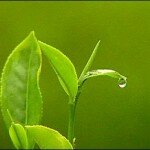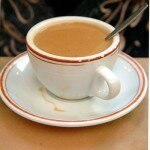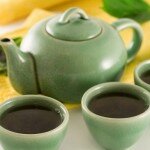TEA
April 15, 2007 – 12:59 pm
 According to a Chinese legend, tea was accidentally discovered in China around 5,000 years ago Emperor Shen Nung. Shen Nung had scientific inclinations and used to boil water meant for drinking purpose. While visiting a region of his kingdom his servants were boiling water when some dried leaves from a bush fell into the boiling water and gave the water a brownish color. Shen Nung was interested in the liquid due to his scientific inclinations and found the liquid to be very refreshing and hence tea was created.
According to a Chinese legend, tea was accidentally discovered in China around 5,000 years ago Emperor Shen Nung. Shen Nung had scientific inclinations and used to boil water meant for drinking purpose. While visiting a region of his kingdom his servants were boiling water when some dried leaves from a bush fell into the boiling water and gave the water a brownish color. Shen Nung was interested in the liquid due to his scientific inclinations and found the liquid to be very refreshing and hence tea was created.
Tea is a beverage made by boiling leaves and twigs of the tea bush, known as Camellia sinensis, in hot water for some time. Herbs, flowers, spices and fruits can be added to tea while boiling to give a distinct flavor. Tea can be classified into four basic types: black tea, oolong tea, green tea and white tea. Tea has no carbohydrate, fat or protein in it. Its flavor can be described as cooling, mildly fragrant, slightly bitter and astringent flavor.
Camellia sinensis grows in tropical and sub-tropical climates and is an evergreen plant. It needs a minimum of 50 inches of rainfall per annum and grows better in acidic soils. Several tea plants of high quality grow at elevations up to 5,000 feet, where the plants grow at a slower pace and have a better flavor. While picking the leaves, only top 1 or 2 inches of the mature plants are picked. The buds and leaves picked are called “flushes” and a plant grows a new flush around every seven or ten days in the growing season. If left undisturbed, tea plants will grow and become a tree but the plants meant for tea cultivation are pruned to waist length so that leaves can be plucked easily.



If leaves of tea are not dried quickly after picking they begin to wilt and oxidize. Soon the leaves start turning darker, this process is referred by fermentation in the tea industry even though its not fermentation in true sense. To stop the oxidation process, heating of tea leaves is done at a predetermined stage. Heating is done simultaneously while drying in case of black tea. If necessary steps are not taken to control moisture and humidity during and after manufacturing of tea, fungi can grow on tea which can render the tea unfit by contaminating it with toxics substances.
Classification of tea is done on the basis of “fermentation” the tea has undergone. The various types of tea are discussed below.
? White tea: White tea is not as widely known as other types of tea and is produced in lesser quantities than other types of tea. White tea is made when the young leaves haven’t been oxidized by not exposing them to sunlight. It is more expensive than other forms of tea and is gaining popularity in western countries now.
? Green tea: Green tea is made by oxidizing the tea leaves to a minimal extent. The oxidizing can be done in a traditional Japanese method by application of steam or in a traditional Chinese method by dry cooking in hot pans. The leaves can be left to dry as separate leaves or can be rolled into small pellets to make “gun-powder” tea. This process takes time and the tea is processed within a day or two after the harvesting is done.
? Oolong: It can be described as semi-oxidized tea as the oxidation is stopped in between the green tea and black tea to give Oolong. The oxidation process generally takes two to three days.
? Black tea/Red tea: To make Black tea or Red tea, the tea leaves are let to be completely oxidized. It is one of the most used form of tea in India, Sri Lanka, Pakistan, and Bangladesh. It is called Red tea by the Chinese as the color of the tea liquid is red and is called black tea by the western world as tea leaves used are of black color. The term “Red tea” can also be used to refer to “rooibos”, which is a South African tisane. Te oxidation process in this case takes between two weeks and one month to complete. Black tea is classified as “orthodox” or as “CTC” (Crush, Tear, Curl).
? Post-fermented tea: Post-fermented teas are those teas that undergo a second a second oxidation. This type of tea is known in China as “Dark Tea”. Pu-erh and Liu’an and Liubao belong to this category of tea.
? Yellow tea: High quality tea served at the Imperial Court, or special tea processed in a similar way to green tea but dried more slowly.
? Kukicha: Kukicha, also known as winter tea, is made from twigs and old leaves taken from the plant during its dormant season and then dry-roasting them over a fire. In Japan, this tea is used as a health food.
Tea is usually blended and sold in bags. Almost all tea sold in Britain is blended tea. Blending is done to give a stable taste to the tea. Better tasting tea can be used to cover the inferior taste of cheaper tea and hence, the blend will fetch a better price. Tea can very easily absorb aromas and this property is used to make scented teas.
Tea contains an antioxidant known as catechins. Catechins may constitute up to 30% of the dry weight of the tea. Concentration of catechins is high in white and green teas and less in black tea. Tea also contains theanine and caffeine, a stimulant along with small amount of theobromine and theophylline. Tea also contains fluoride, which is helpful in preventing dental cavity to an extent.
Tea is prepared by placing loose tea directly in teapot or in a tea infuser. Tea can also be brewed directly in a cup but the teabag should be kept in the cup before the hot water is poured. Green or white tea, which have very little or no oxidation period, are brewed at lower temperatures around 80°C while teas which have a longer oxidation period are brewed at temperature of 100°C. When chilled milk is used, some people prefer adding tea to the milk rather than adding rather than the other way around. This gives a better emulsion and nicer taste by avoiding scalding of the milk. Honey and lemon are also added to tea.
• Tetley launched the tea bag in UK in 1953. It was very easy to make tea using the tea bags, hence making tea bags immensely popular. But the tea used in tea bags is of inferior quality as it is the waste product of sorting of high quality loose leaf tea. Also, the paper used for the bag can leave its own flavor.
Loose tea is usually vacuum packed to retain freshness. To avoid drinking the floating loose leaves, strainers, infusion bags and tea pots with filters are available in market.